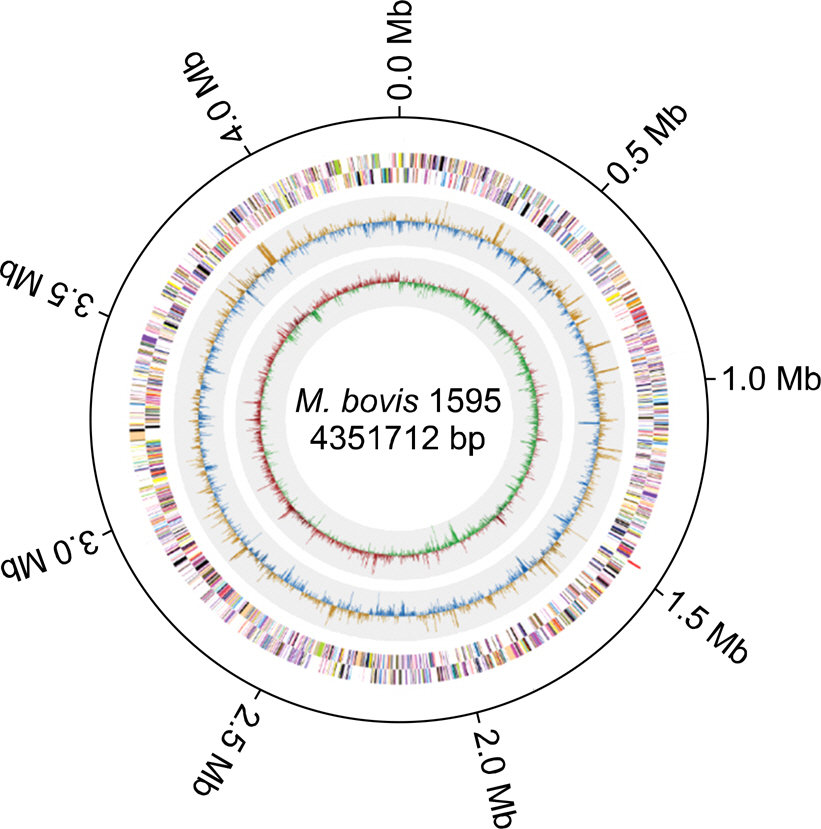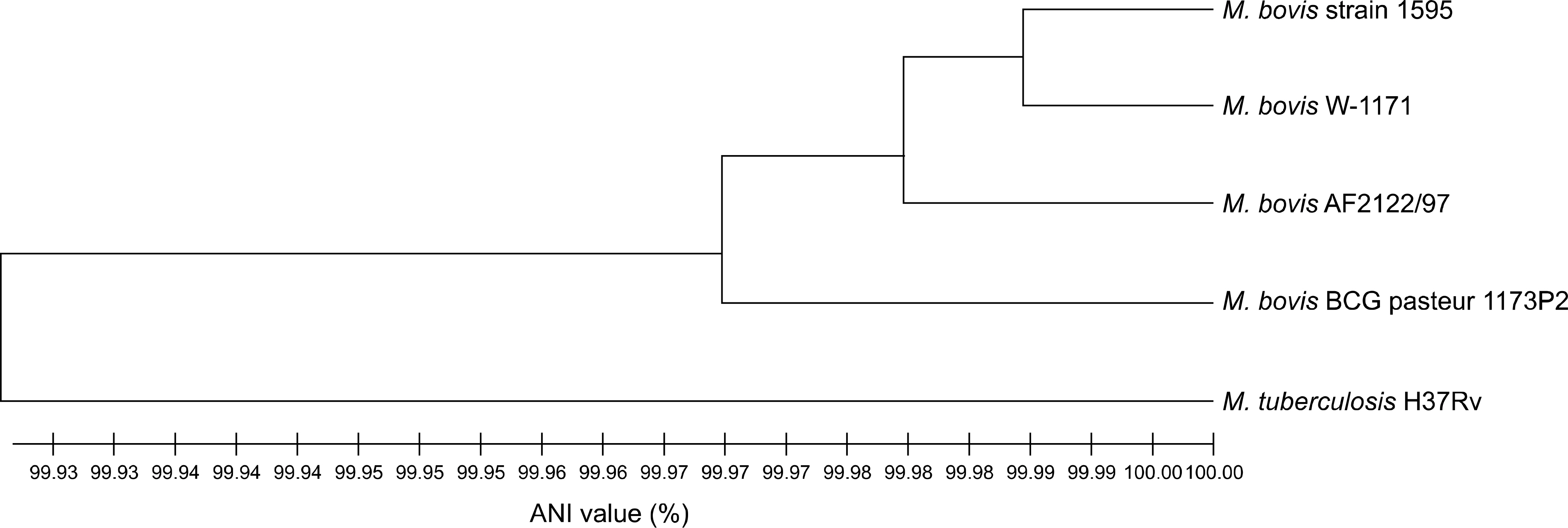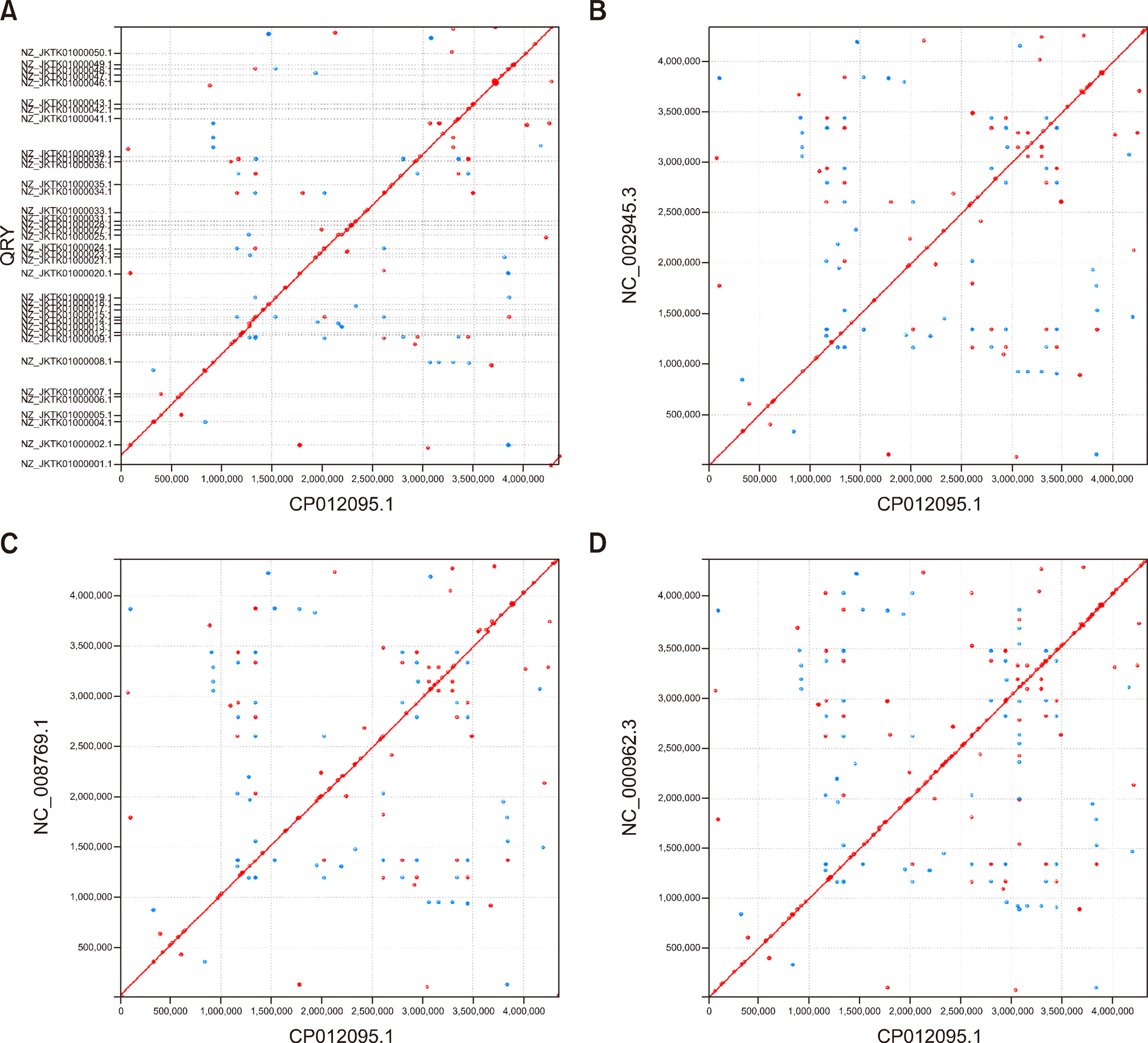J Vet Sci.
2017 Aug;18(S1):333-341. 10.4142/jvs.2017.18.S1.333.
Molecular and genomic features of Mycobacterium bovis strain 1595 isolated from Korean cattle
- Affiliations
-
- 1Bacterial Disease Division, Animal and Plant Quarantine Agency, Anyang 14089, Korea. kimjm88@korea.kr
- 2Department of Integrated Biomedical and Life Science, College of Health Science, Korea University, Seoul 02841, Korea.
- 3Department of Public Health Science (Brain Korea 21 PLUS Program), Graduate School, Korea University, Seoul 02841, Korea. kimjm88@korea.kr
- 4Chungcheongbukdo Veterinary Service, Chungju 27492, Korea.
- KMID: 2412558
- DOI: http://doi.org/10.4142/jvs.2017.18.S1.333
Abstract
- The aim of this study was to investigate the molecular characteristics and to conduct a comparative genomic analysis of Mycobacterium (M.) bovis strain 1595 isolated from a native Korean cow. Molecular typing showed that M. bovis 1595 has spoligotype SB0140 with mycobacterial interspersed repetitive units-variable number of tandem repeats typing of 4-2-5-3-2-7-5-5-4-3-4-3-4-3, representing the most common type of M. bovis in Korea. The complete genome sequence of strain 1595 was determined by single-molecule real-time technology, which showed a genome of 4351712 bp in size with a 65.64% G + C content and 4358 protein-coding genes. Comparative genomic analysis with the genomes of Mycobacterium tuberculosis complex strains revealed that all genomes are similar in size and G + C content. Phylogenetic analysis revealed all strains were within a 0.1% average nucleotide identity value, and MUMmer analysis illustrated that all genomes showed positive collinearity with strain 1595. A sequence comparison based on BLASTP analysis showed that M. bovis AF2122/97 was the strain with the greatest number of completely matched proteins to M. bovis 1595. This genome sequence analysis will serve as a valuable reference for improving understanding of the virulence and epidemiologic traits among M. bovis isolates in Korea.
Keyword
MeSH Terms
Figure
Reference
-
References
1. Achtman M. Evolution, population structure, and phylogeography of genetically monomorphic bacterial pathogens. Annu Rev Microbiol. 2008; 62:53–70.
Article2. Allix C, Walravens K, Saegerman C, Godfroid J, Supply P, Fauville-Dufaux M. Evaluation of the epidemiological relevance of variable-number tandem-repeat genotyping of Mycobacterium bovis and comparison of the method with IS6110 restriction fragment length polymorphism analysis and spoligotyping. J Clin Microbiol. 2006; 44:1951–1962.3. Bailo R, Bhatt A, Aínsa JA. Lipid transport in Mycobacterium tuberculosis and its implications in virulence and drug development. Biochem Pharmacol. 2015; 96:159–167.4. Belisle JT, Mahaffey SB, Hill PJ. Isolation of Mycobacterium species genomic DNA. Methods Mol Biol. 2009; 465:1–12.5. Bouklata N, Supply P, Jaouhari S, Charof R, Seghrouchni F, Sadki K, El Achhab Y, Nejjari C, Filali-Maltouf A, Lahlou O, El Aouad R. Molecular typing of Mycobacterium tuberculosis complex by 24-locus based MIRU-VNTR typing in conjunction with spoligotyping to assess genetic diversity of strains circulating in Morocco. PLoS One. 2015; 10:e0135695.6. Carver T, Berriman M, Tivey A, Patel C, Böhme U, Barrell BG, Parkhill J, Rajandream MA. Artemis and ACT: viewing, annotating and comparing sequences stored in a relational database. Bioinformatics. 2008; 24:2672–2676.
Article7. Cho YJ, Yi H, Chun J, Cho SN, Daley CL, Koh WJ, Shin SJ. The genome sequence of ‘Mycobacterium massiliense' strain CIP 108297 suggests the independent taxonomic status of the Mycobacterium abscessus complex at the subspecies level. PLoS One. 2013; 8:e81560.8. Delcher AL, Harmon D, Kasif S, White O, Salzberg SL. Improved microbial gene identification with GLIMMER. Nucleic Acids Res. 1999; 27:4636–4641.
Article9. Forrellad MA, Klepp LI, Gioffré A, Sabio y García J, Morbidoni HR, de la Paz Santangelo M, Cataldi AA, Bigi F. Virulence factors of the Mycobacterium tuberculosis complex. Virulence. 2013; 4:3–66.10. Goris J, Konstantinidis KT, Klappenbach JA, Coenye T, Vandamme P, Tiedje JM. DNA-DNA hybridization values and their relationship to whole-genome sequence similarities. Int J Syst Evol Microbiol. 2007; 57:81–91.
Article11. Hotter GS, Collins DM. Mycobacterium bovis lipids: virulence and vaccines. Vet Microbiol. 2011; 151:91–98.12. Humblet MF, Boschiroli ML, Saegerman C. Classification of worldwide bovine tuberculosis risk factors in cattle: a stratified approach. Vet Res. 2009; 40:50.
Article13. Jackson M, Stadthagen G, Gicquel B. Long-chain multiple methyl-branched fatty acid-containing lipids of Mycobacterium tuberculosis: biosynthesis, transport, regulation and biological activities. Tuberculosis (Edinb). 2007; 87:78–86.14. Je S, Ku BK, Jeon BY, Kim JM, Jung SC, Cho SN. Extent of Mycobacterium bovis transmission among animals of dairy and beef cattle and deer farms in South Korea determined by variable-number tandem repeats typing. Vet Microbiol. 2015; 176:274–281.15. Jensen LJ, Julien P, Kuhn M, von Mering C, Muller J, Doerks T, Bork P. eggNOG: automated construction and annotation of orthologous groups of genes. Nucleic Acids Res. 2008; 36:D250–254.
Article16. Jeon B, Je S, Park J, Kim Y, Lee EG, Lee H, Seo S, Cho SN. Variable number tandem repeat analysis of Mycobacterium bovis isolates from Gyeonggi-do, Korea. J Vet Sci. 2008; 9:145–153.17. Jeon BY, Kim SC, Je S, Kwak J, Cho JE, Woo JT, Seo S, Shim HS, Park BO, Lee SS, Cho SN. Evaluation of enzyme-linked immunosorbent assay using milk samples as a potential screening test of bovine tuberculosis of dairy cows in Korea. Res Vet Sci. 2010; 88:390–393.
Article18. Kamerbeek J, Schouls L, Kolk A, van Agterveld M, van Soolingen D, Kuijper S, Bunschoten A, Molhuizen H, Shaw R, Goyal M, van Embden J. Simultaneous detection and strain differentiation of Mycobacterium tuberculosis for diagnosis and epidemiology. J Clin Microbiol. 1997; 35:907–914.19. Käser M, Ruf MT, Hauser J, Pluschke G. Optimized DNA preparation from mycobacteria. Cold Spring Harb Protoc. 2010; 2010:pdb. prot5408.
Article20. Kim J, Jang Y. [Investigation of tuberculosis in wildlife animals and dogs and cats residing on infected cattle and deer farms, and molecular characterization of Mycobacterium bovis isolated from animals]. Animal and Plant Quarantine Agency. (ed.).Annual Research Report. pp.p. 135–136. Animal and Plant Quarantine Agency;Gimcheon: 2014. Korean.21. Kim N, Jang Y, Kim JK, Ryoo S, Kwon KH, Kang SS, Byeon HS, Lee HS, Lim YH, Kim JM. Complete genome sequence of Mycobacterium bovis clinical strain 1595, isolated from the laryngopharyngeal lymph node of South Korean cattle. Genome Announc. 2015; 3:e01124–15.
Article22. Kim N, Jang Y, Park SY, Song WS, Kim JT, Lee HS, Lim YH, Kim JM. Whole-genome squence of Mycobacterium bovis W-1171, isolated from the laryngopharyngeal lymph node of a wild boar in South Korea. Genome Announc. 2015; 3:e01464–15.
Article23. Kim OS, Cho YJ, Lee K, Yoon SH, Kim M, Na H, Park SC, Jeon YS, Lee JH, Yi H, Won S, Chun J. Introducing EzTaxon-e: a prokaryotic 16S rRNA gene sequence database with phylotypes that represent uncultured species. Int J Syst Evol Microbiol. 2012; 62:716–721.
Article24. Koren S, Schatz MC, Walenz BP, Martin J, Howard JT, Ganapathy G, Wang Z, Rasko DA, McCombie WR, Jarvis ED, Adam M. Phillippy. Hybrid error correction and de novo assembly of single-molecule sequencing reads. Nat Biotechnol. 2012; 30:693–700.25. Kurtz S, Phillippy A, Delcher AL, Smoot M, Shumway M, Antonescu C, Salzberg SL. Versatile and open software for comparing large genomes. Genome Biol. 2004; 5:R12.26. Lagesen K, Hallin P, Rødland EA, Staerfeldt HH, Rognes T, Ussery DW. RNAmmer: consistent and rapid annotation of ribosomal RNA genes. Nucleic Acids Res. 2007; 35:3100–3108.
Article27. Le Flèche P, Fabre M, Denoeud F, Koeck JL, Vergnaud G. High resolution, online identification of strains from the Mycobacterium tuberculosis complex based on tandem repeat typing. BMC Microbiol. 2002; 2:37.28. Lee SH, Lee WC. Epidemiological patterns and testing policies for bovine tuberculosis in the domestic cattle in Korea from 1961 to 2010. Japan J Vet Res. 2013; 61:19–23.29. Lowe TM, Eddy SR. tRNAscan-SE: a program for improved detection of transfer RNA genes in genomic sequence. Nucleic Acids Res. 1997; 25:955–964.
Article30. Ministry of Food and Drug Safety (KR). Livestock Product Sanitary Control. Act 12672. May 21, 2014.31. Pirson C, Jones GJ, Steinbach S, Besra GS, Vordermeier HM. Differential effects of Mycobacterium bovis‒derived polar and apolar lipid fractions on bovine innate immune cells. Vet Res. 2012; 43:54.32. Richter M, Rosselló-Móra R. Shifting the genomic gold standard for the prokaryotic species definition. Proc Natl Acad Sci U S A. 2009; 106:19126–19131.
Article33. Ruettger A, Nieter J, Skrypnyk A, Engelmann I, Ziegler A, Moser I, Monecke S, Ehricht R, Sachse K. Rapid spoligotyping of Mycobacterium tuberculosis complex bacteria by use of a microarray system with automatic data processing and assignment. J Clin Microbiol. 2012; 50:2492–2495.34. Tatusova T, Ciufo S, Fedorov B, O'Neill K, Tolstoy I. RefSeq microbial genomes database: new representation and annotation strategy. Nucleic Acids Res. 2014; 42:D553–559.
Article35. Wiker HG, Harboe M. The antigen 85 complex: a major secretion product of Mycobacterium tuberculosis. Microbiol Rev. 1992; 56:648–661.
- Full Text Links
- Actions
-
Cited
- CITED
-
- Close
- Share
- Similar articles
-
- Molecular fingerprinting of clinical isolates of Mycobacterium bovis and Mycobacterium tuberculosis from India by restriction fragment length polymorphism (RFLP)
- Variable number tandem repeat analysis of Mycobacterium bovis isolates from Gyeonggi-do, Korea
- Mycobacterial Infection after Intravesical Bacillus Calmette-Guerin Treatment for Bladder Cancer: A Case Report
- Single-nucleotide polymorphismbased epidemiological analysis of Korean Mycobacterium bovis isolates
- Differentiation between Mycobacterium bovis and Mycobacterium tuberculosis Infection




